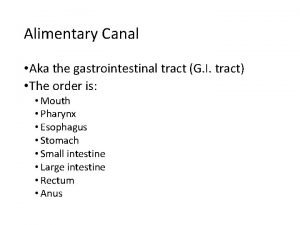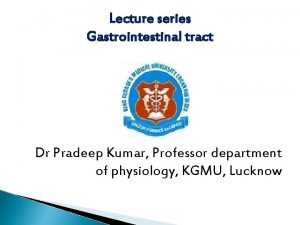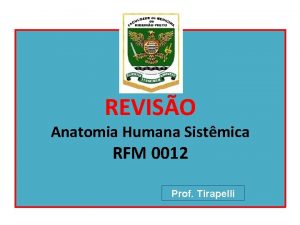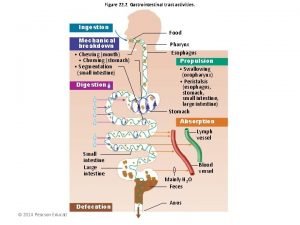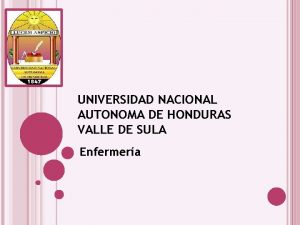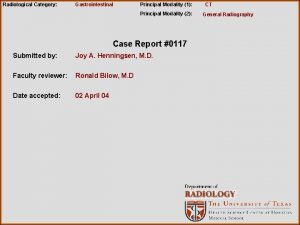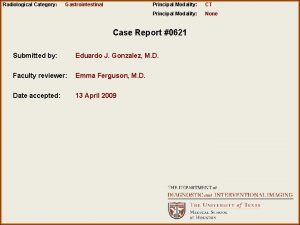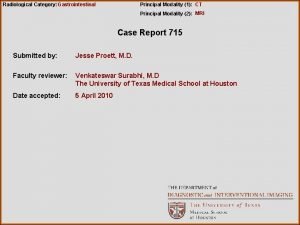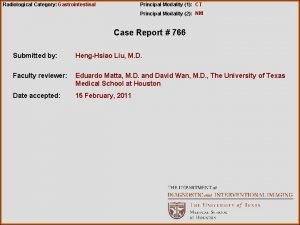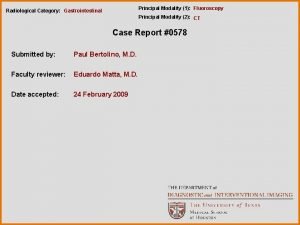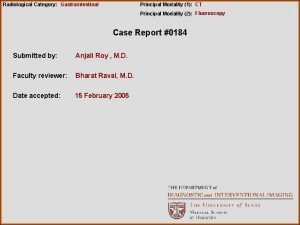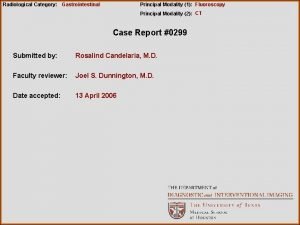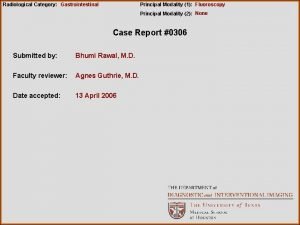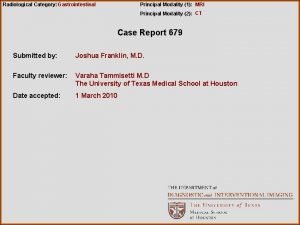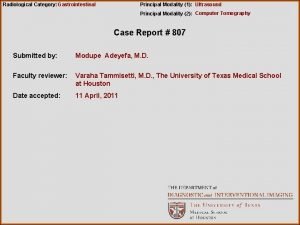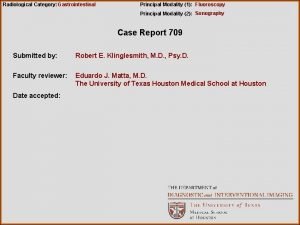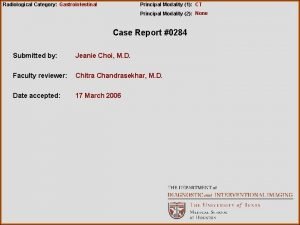Radiological Category Gastrointestinal Principal Modality 1 CT Principal














- Slides: 14

Radiological Category: Gastrointestinal Principal Modality (1): CT Principal Modality (2): MRI Case Report 686 Submitted by: Megan Kalambo, M. D. Faculty reviewer: Chitra Chandrasekhar, M. D. The University of Texas Medical School at Houston Date accepted: 04 March 2010

Case History 69 year old male with shortness of breath and abdominal distention

Radiological Presentations

Radiological Presentations

Radiological Presentations

Radiological Presentations

Test Your Diagnosis Which one of the following is your choice for the appropriate diagnosis? After your selection, go to next page. • Tuberculous Peritonitis • Peritoneal Carcinomatosis • Primary Peritoneal Mesothelioma • Gastrointestinal Lymphoma

Findings and Differentials Findings: PA and lateral chest radiograph demonstrate thickening of the right costophrenic sulcus with a linear diaphragmatic calcified pleural plaque. Axial and coronal contrast enhanced CT images through the upper abdomen demonstrate large volume, low density, ascites with smooth peritoneal enhancement, omental thickening and enhancing solid nodular deposits. The unilateral right diaphragmatic calcified plaque is again noted. Axial T 1 post contrast MR images through the abdomen demonstrate enhancement of the peritoneum with mild nodularity. Extensive omental caking is present in the left upper quadrant with extension to the lateral peritoneal surface. Differentials: • Tuberculous Peritonitis • Peritoneal Carcinomatosis • Primary Peritoneal Mesothelioma • Gastrointestinal Lymphoma

Discussion Differential considerations for peritoneal enhancement and nodular masses: In tuberculous peritonitis (TBP) there is nodular or symmetric thickening of the peritoneum with caseating (necrotic) mesenteric adenopathy. The “wet” form of TBP presents with high density ascites (>30 HU). The “dry” form of TBP presents with fibrotic adhesions with separation and fixation of the bowel. The peritoneum, mesentery and omentum are frequent sites of metastatic seeding from ovarian, stomach, colon and pancreatic carcinomas. Tumor cell implantation on the omental surface leads to subsequent invasion and proliferation in the omental fat results in the classic picture of "omental caking. ” Additional CT findings include mesenteric tumor nodules, nodularity of the bowel wall and loculated ascites. Peritoneal lymphomatosis due to gastrointestinal lymphoma may be seen on CT as conglomerate omental caking or masses, with diffuse peritoneal thickening or ascites. Additional findings that may distinguish lymphoma from peritoneal carcinomatosis include splenic enlargement, segmental bowel wall dilatation or thickening. Malignant peritoneal mesothelioma often appears radiographically similar to peritoneal carcinomatosis, with nodular peritoneal thickening, intra-abdominal ascites, and omental caking. Calcification is uncommon.

Diagnosis Primary Peritoneal Mesothelioma Intra-abdominal ascites, peritoneal enhancement and omental caking, in the presence of calcified diaphragmatic pleura, make primary peritoneal mesothelioma the most likely diagnosis.

Primary Peritoneal Mesotheliomas are aggressive tumors arising from serous surfaces of the body including the pleura, peritoneum, tunica vaginalis testis, and pericardium. Occupational or environmental exposure to asbestos is considered the principal risk factor for disease. Malignant peritoneal mesothelioma is an extremely rare subset of mesothelioma, occurring in less than 30% of patients with mesothelioma and less than 500 US patients a year. Symptoms appear 20 -30 years after exposure, compared to the 30 -40 year latency more commonly associated with pleural mesothelioma. The exact pathogenesis of peritoneal mesothelioma is still largely debated but thought to arise from direct ingestion of asbestos fibers into the gastrointestinal tract or inhalation into the lungs with subsequent lymphatic transport into the peritoneal cavity. Cytologic analysis of ascites has a low diagnostic potential due to the diversity and small number of malignant cells in the fluid. When cytologic findings are inconclusive or ascitic fluid is absent, tumor biopsy is more likely to yield a diagnosis. Despite surgical and chemotherapeutic intervention, malignant mesothelioma is considered a universally fatal neoplasm with mean survival rate of 1 year.

Teaching Points Calcified diaphragmatic pleural plaque extensive omental caking peritoneal enhancement with nodularity Large volume ascites coronal post-contrast CT T 1 post-contrast MRI

Diagnosis Primary Peritoneal Mesothelioma

References Antman K, Hassan R, Eisner M, Ries LA, Edwards BK. Update on malignant mesothelioma. Oncology (Williston Park). 2005; 19: 1301– 1309. Brandt, W. Helms, C. Fundamentals of Diagnostic Radiology. 3 rd Edition. Philadelphia, Pa. Lippincott Williams and Wilkins, 2007. 750 -755. Pickhardt PJ, Bhalla S. Primary neoplasms of peritoneal and sub- peritoneal origin: CT Findings - Radiographics 2005; 25: 983 -95. Smiti S, Rajagopal KV. CT Mimics of Peritoneal Carcinomatosis. Indian Journal or Radiology and Imaging 2010; 20: 58 -62
 Erate pa
Erate pa Tennessee division of radiological health
Tennessee division of radiological health Center for devices and radiological health
Center for devices and radiological health National radiological emergency preparedness conference
National radiological emergency preparedness conference Radiological dispersal device
Radiological dispersal device Gastrointestinal structure
Gastrointestinal structure Composition of stomach
Composition of stomach Gastrointestinal medical terminology breakdown
Gastrointestinal medical terminology breakdown Gastrointestinal tract
Gastrointestinal tract Pneumatic reduction of intussusception
Pneumatic reduction of intussusception Anatomia do rim
Anatomia do rim Malrotasi traktus gastrointestinal
Malrotasi traktus gastrointestinal Peristalsis and segmentation
Peristalsis and segmentation Motilidad gastrointestinal
Motilidad gastrointestinal Emt chapter 18 gastrointestinal and urologic emergencies
Emt chapter 18 gastrointestinal and urologic emergencies






